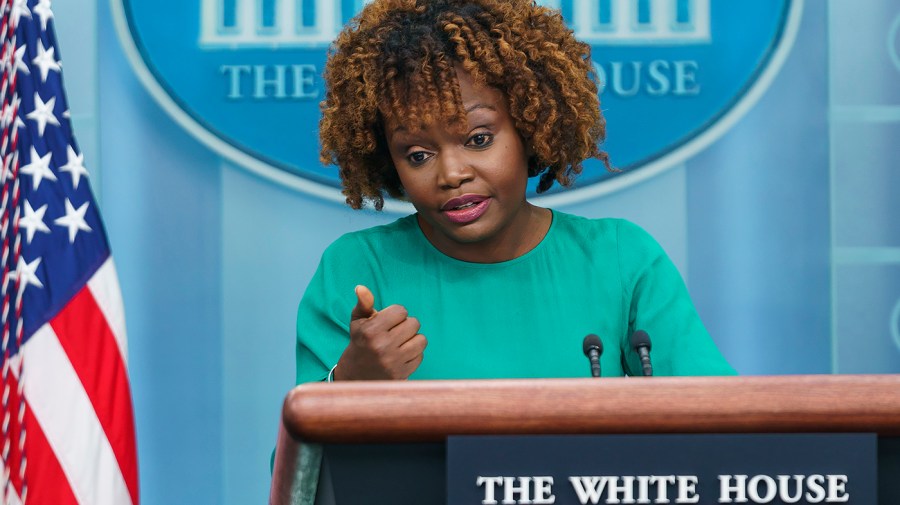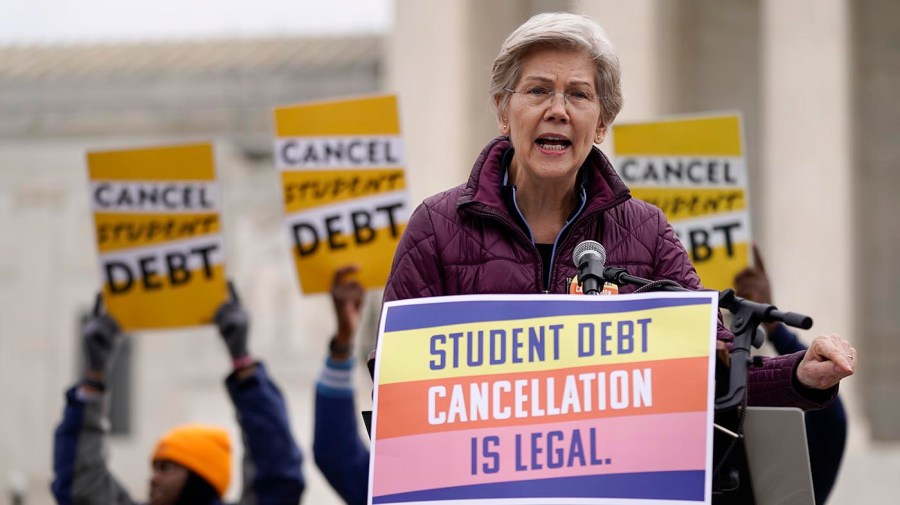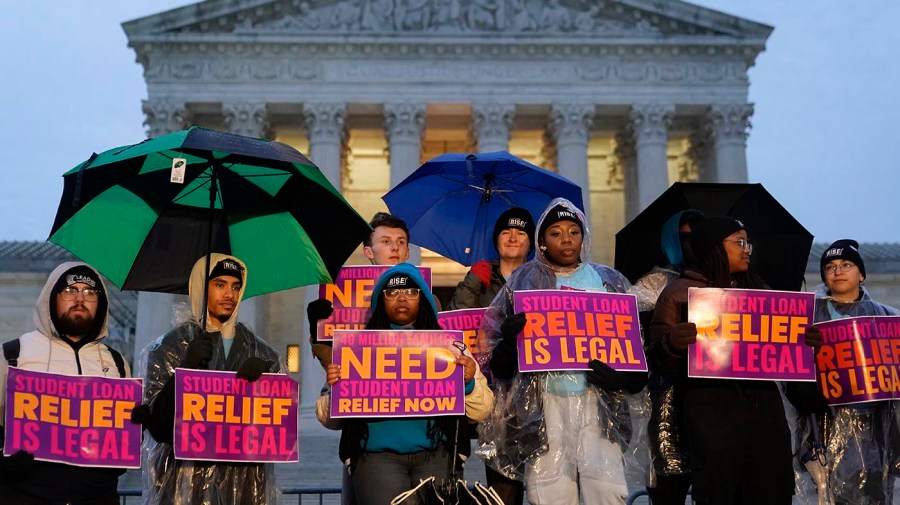What Biden might try next if his student loan forgiveness plan is struck down
The Biden White House has been reluctant to talk about alternatives to its student loan relief plan for fear of undermining its case now before the Supreme Court, but should the justices strike down the proposal, they do have some options.
Lawyers for the administration made their case to save President Biden’s student debt forgiveness before the justices on Tuesday, but with the plan at the mercy of a conservative-leaning court, eyes are on the administration for what comes next.
“I’m confident we’re on the right side of the law. I’m not confident about the outcome of the decision yet,” Biden told reporters Wednesday.
The relief was a top promise for the president during his 2020 campaign, and he announced his plan to eliminate up to $20,000 in student loan debt just a few months before last year’s midterm elections.
From the outset, observers knew the proposal would be challenged legally, and it quickly became the subject of multiple lawsuits around the country, with two cases ultimately reaching the high court.
Despite the apparent odds stacked against them, the Biden administration has tried to maintain an optimistic tone and not entertained talk of backing off.
“The plan that we put forward in August is the plan that we have, which is also a plan that you heard the solicitor general really defend in a strong and powerful way yesterday. And that’s our plan, and we believe in our legal authority to get that done and get that implemented,” press secretary Karine Jean-Pierre said Wednesday, adding that Education Secretary Miguel Cardona had reached out to borrowers this week to let them know the White House has their back.

White House press secretary Karine Jean-Pierre addresses reporters during the daily briefing at the White House. (Greg Nash)
“Our focus right now is getting this done. You saw the solicitor general really give a strong argument yesterday in front of the highest court in the land. There’s a reason we took it to the Supreme Court,” Jean-Pierre said.
In the short term, perhaps the most viable alternative Biden could explore if the high court nixes his proposal is loan forgiveness through a new executive action, a possibility backed by leading Democrats including Senate Majority Leader Chuck Schumer (N.Y.) and Sen. Elizabeth Warren (Mass.).
In 2021, Schumer, Warren and other Democrats called on Biden to use authority under the Higher Education Act (HEA) to cancel up to $50,000 in student loan debt for all borrowers. The 1965 law allows for student loan relief for certain groups, including those whose institutions have since closed.

Sen. Elizabeth Warren, D-Mass., speaks at a rally for student debt relief advocates gather outside the Supreme Court on Capitol Hill in Washington as the court heard arguments over President Biden’s student debt relief plan. (AP Photo/Patrick Semansky)
“Congress has already granted the Secretary of Education the legal authority to broadly cancel student debt under section 432(a) of the Higher Education Act of 1965 (20 U.S.C. 1082(a)), which gives the Secretary the authority to modify, ‘… compromise, waive, or release any right, title, claim, lien, or demand, however acquired, including any equity or any right of redemption,’” the Democrats wrote.
Robert Moran, a former senior policy adviser in the Education Department under President George W. Bush, suggested that the Biden administration could also try to defend its current plan under the HEA, as opposed to the Higher Education Relief Opportunities for Students, or HEROES, Act, which it cited before the Supreme Court.
“The administration may return to some of the arguments proposed under the HEA to provide this relief. If that happens, I am sure there will be another series of court cases that will likely end back at the Supreme Court,” Moran said.
He added, however, that he doesn’t personally think that the HEA grants Biden the authority to enact the loan forgiveness and he’s “not sure what is available to the administration to provide the relief.”
Another option, although very unlikely with the House in Republican hands, is to get student debt relief through Congress.
Democrats did secure a legislative win in the $1.9 trillion coronavirus stimulus package Biden signed in 2021, which included a provision that made it so student debt relief would be tax-free if it occurred, a step critical to advocates.
“Congressional action is always an option, but the short answer is, there is no quick fix,” said Debra Dixon, a former chief of staff of the Office of Planning, Evaluation and Policy Development at the Education Department under President Obama.
Lawmakers and activists plan to keep up the pressure on the administration.
“Well, I think there’s going to be an uproar across the country, in particular on college campuses across the country. And folks who are working really hard to get it done, these activists are gonna continue to organize and we’ll continue to try to address the issue in Congress,” Rep. Robert Garcia (D-Calif. ) told The Hill at a rally outside of the Supreme Court this week in support of student debt relief.

Student debt relief advocates gather outside the Supreme Court on Capitol Hill. (AP Photo/Patrick Semansky)
At the same demonstration, Rep. Max Frost (D-Fla.), the first Generation Z member of Congress, replied “no” when asked if there is a legislative path forward if the court knocks down the Biden plan.
“And so what we’ll need to do just because of the numbers right now, the majority, so what we’ll need to do is we’ll need the president to try something else. What is that? I don’t know. But we’ll probably need to get creative,” Frost said.
“There’s ways that we can work around it, especially in conversations I’ve had with experts on the issue. What those are? Not sure yet, but there are ways to work around it and figure out how we can still get this relief for people,” he added.
Apart from complete debt cancellation, the Biden administration has worked to make it so student loan borrowers have an easier time repaying their student loans once payments resume after a pandemic-related pause.
One of the proposals the administration has made is changes to lower payments for income-driven repayment (IDR) plans. IDR plans make it so a person pays back a certain amount each month, and after 20 to 25 years the rest of their debt will be forgiven.
Under the proposed changes, an individual making less than $30,500 would have $0 monthly payments, and each month would still count towards the time it takes to get debt forgiveness. Those making above $30,500 will still see a benefit as they will only have to pay 5 percent of their discretionary income, not the current 10 percent.
The number of years for forgiveness would also be shortened, with those who have debts of $12,000 original principal or less able to receive forgiveness after 10 years. Every $1,000 above a $12,000 original principal would give another year of monthly payments up to the 20 to 25 year mark before forgiveness could apply.
Junlei Chen, an economist for the University of Pennsylvania’s Penn Wharton Budget Model, says the proposed changes to the IDR plan are more likely to succeed and be the best option for student debt relief for borrowers in the future.
However, Chen cautions those changes would cost billions of dollars.
“The budgetary costs of the new IDR plan will shoot up, and our estimate is in the next 10 years budget window, it will cost around like $333 billion to $360 billion, which is almost the same level as the student loan forgiveness plan,” she said.
The Department of Education “proposed their estimated cost of the IDR plan, which is like around 140 [billion]. But they didn’t take into account the more generous feature of this IDR plan” and the high possibility borrowers will “change their behavior and they would switch into this IDR plan,” Chen said.

Student debt relief advocates rally outside the Supreme Court. (AP Photo/Patrick Semansky)
Another option the administration proposed to make student debt less burdensome was easing the high bar to declare bankruptcy on the loans.
Student loans are treated differently than other types of debt in bankruptcy court, with borrowers burdened with the difficult task of proving “undue hardship” and a “certainty of hopelessness” in many states to get the debt discharged.
Under the proposed changes, in certain situations the government may decide not to contest the discharge of federally held student loans, making it much easier for them to be included in a bankruptcy case.
—Zach Schonfeld and Alex Gangitano contributed.
Copyright 2023 Nexstar Media Inc. All rights reserved. This material may not be published, broadcast, rewritten, or redistributed.

